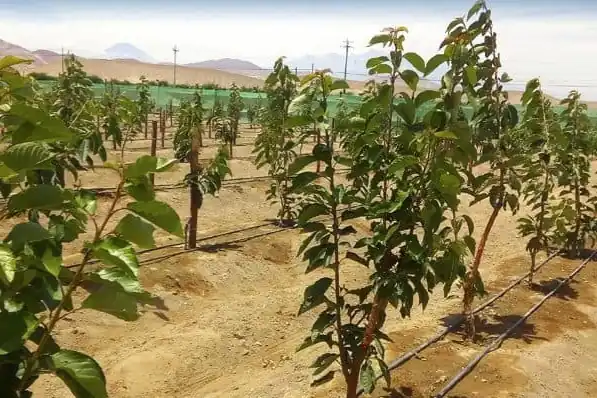The management of the post-harvest phase of cherry trees is essential to ensure the success of the next season. During this period, the necessary reserves for good flowering and budding in spring are accumulated.
However, summer in central Chile, characterized by high temperatures and intense radiation, can cause stress in plants and affect this process.
During this period, the accumulation of reserves in cherry trees significantly increases from harvest until leaf fall, reaching its highest concentration in woody organs. This process mainly depends on temperature, nutrition, and the plant’s water status.
Factors influencing reserve accumulation
Carbon reserves depend on photosynthetic efficiency, which is affected by climatic conditions and agronomic management.
Nitrogen reserves require adequate irrigation and fertilization to keep plants in optimal conditions, counteracting thermal stress and solar radiation during months of high evapotranspiration demand.
Alternatives to reduce heat stress
1. Sunscreens
An effective strategy to mitigate the effects of temperature and radiation on fruit tree production is the application of sunscreens during pre- and post-harvest. This technique has gained popularity in Chile over the last ten years.
Currently, different types exist: commercially available sun filters, which include kaolinite, silicates, or acids, fatty substances such as phospholipids, and oligosaccharides (colorless). These products, applied in Chile between December and March, help reduce thermal stress by lowering leaf temperature.
The function of sun filters is based on the reflection of excess radiation, including photosynthetically active radiation (PAR), ultraviolet (UV), and infrared (IR).
 Figure 1. Damage from high temperatures on cherry leaves.
Figure 1. Damage from high temperatures on cherry leaves.
2. Application of biostimulants
The use of nutritional correctors and biostimulants during critical periods of the crop has recently gained relevance as a strategy to mitigate plant stress.
Biostimulants are substances that stimulate biochemical processes in plants, improving nutrient absorption, efficiency in their use, and tolerance to abiotic stress.
To mitigate thermal, water, and saline stress, biostimulants based on seaweed extracts are particularly effective during the post-harvest period.
These extracts contain polysaccharides, macro- and micronutrients, amino acids, and phytohormones, whose composition varies depending on the type of algae and the extraction method. Seaweed extracts induce physiological responses in plants that enhance their tolerance to stress. Although the mechanism
The exact action is not yet fully understood, but it has been shown that their application alters key plant hormone metabolic pathways such as auxins, cytokinins, and abscisic acid. These changes, together with the synergistic effects of the components, optimize the plant’s physiological processes, helping to maintain its productive potential under stressful conditions.
In Figure 2, the effect of biostimulant applications on nitrogen reserve accumulation, measured in cherry roots, can be observed.
 Figure 2. Arginine concentration in cherry roots in samples collected in June. Bars with different letters indicate significant differences according to PCM LSD Fisher (p-value <0.05).
Figure 2. Arginine concentration in cherry roots in samples collected in June. Bars with different letters indicate significant differences according to PCM LSD Fisher (p-value <0.05).
Final considerations
Proper management of post-harvest irrigation and fertilization, integrated with the application of sun filters and/or biostimulants to mitigate thermal stress, promotes greater reserve accumulation in the plant.
It is recommended to apply a sunscreen, whether kaolinite-based or colorless, as soon as possible after harvest.
Additionally, it is advisable to use biostimulants every 15 or 20 days during periods of high temperatures.
The frequency of these applications will depend on the specific characteristics of the orchard, such as climate, latitude, vigor, and the plant’s phytosanitary status.
In areas with higher temperatures or when plants are more sensitive to thermal stress, applications can be more frequent to maximize efficiency in reserve accumulation and ensure next season’s performance.
Source: Equipo CER, Chile
Cherry Times - All rights reserved














